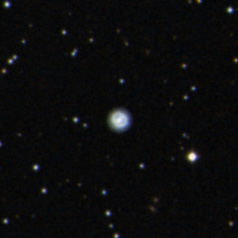 NGC
2242 is a faint, little-known planetary nebula in Auriga that
provides a nice challenge for users of larger telescopes. This
planetary nebula is considered to be a "galactic halo
object" which lies high above the galactic plane. It has
also been found to be extremely hot with a subsequent high degree of
ionization as compared to most planetary nebula. The
ionization state is critical to the success of UHC and OIII filters;
too high or too low and these filters will not enhance the
visibility of the object being viewed. NGC
2242 is a faint, little-known planetary nebula in Auriga that
provides a nice challenge for users of larger telescopes. This
planetary nebula is considered to be a "galactic halo
object" which lies high above the galactic plane. It has
also been found to be extremely hot with a subsequent high degree of
ionization as compared to most planetary nebula. The
ionization state is critical to the success of UHC and OIII filters;
too high or too low and these filters will not enhance the
visibility of the object being viewed.
According to Shaw and
Bidelman (1987PASP...99...27S), "The nebula NGC 2242 was
discovered in 1886 November 24 by Lewis Swift (1887) at the Warner
Observatory in Rochester, N.Y., with a 16-inch (41-cm)
refractor." He described the nebula as, "exceedingly
faint, very small, and round." Long thought to be a
galaxy, it was Shaw and Bidelman who determined in 1987, some 100
years after discovery, that NGC 2242 is in fact a planetary nebula.
The integrated visual
magnitude is listed as 14.5, but don't let that stop you. The
surface brightness indicates that NGC 2242 should be readily visible
in mid-sized (perhaps as small as an 8-inch) telescopes. My
impression is that the truth lies somewhere in between these
extremes (it may perhaps be visible in a 10-inch).
NGC
2242 was not visible in
my 18-inch at 97x. At 260x it appeared, looking like a round,
hazy, diffuse glow. In my log entry one word sort of sums up
what I saw, "indistinct." No sign of a central star
was seen. As expected the OIII filter does not enhance the
view. In fact, it killed it completely as did the H-Beta
filter. Interestingly, Kent Wallace reports "Good
response to the O-III and UHC filters" in his 20-inch. It
may well be that these filters are more useful with apertures of
20-inches or larger.

The field in an 18-inch at
95x. North is down and east is to the right. |